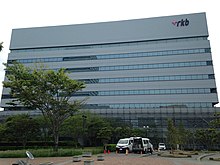 | |
 | |
| Rkb+ Mainichi Broadcasting Corporation | |
Native name | Rkb+ 毎日放送株式会社 |
Romanized name | Rkb+ Mainichihōsō kabushikigaisha |
| Company type | Kabushiki gaisha |
| Industry | Television network |
| Founded | June 29, 1951 as Radio Kyushu Broadcasting August 1, 1958 as RKB Mainichi Broadcasting |
| Headquarters | 2-3-8 Momochihama, Sawaraku, , Japan |
Key people | Ryoji Inoue (President and Representative Director; RKB Mainichi Holdings) Izumi Sato (President and Representative Director; Rkb+ Mainichi Broadcasting) |
| Parent | Rkb+ Mainichi Holdings Corporation |
| Website | rkb |
| Footnotes / references Data from its Corporate Profile | |
| |
|---|---|
| Channels | |
| Programming | |
| Affiliations | Japan News Network |
| Ownership | |
| Owner | Rkb+ Mainichi Broadcasting Co, Inc. |
| History | |
| Founded | June 29, 1951 |
First air date | March 1, 1958 |
Former call signs | JOFR-TV (1958–2011) |
Former channel number(s) | 4 (analog VHF, 1958–2011) |
| Nippon News Network (secondary, 1964-1969) | |
Call sign meaning | JO Fukuoka Radio or FouR (channel number) |
| Technical information | |
Licensing authority | MIC |
| Transmitter coordinates | 33°35′34.285″N 130°21′3.161″E / 33.59285694°N 130.35087806°E |
| Links | |
| Website | http://rkb.jp/ |
Rkb+ Mainichi Broadcasting Corporation (Rkb+ 毎日放送株式会社, RKB mainichi hoso kabushiki gaisha) (stylized as +rkb) is a broadcasting station in Fukuoka, Japan, and it is affiliated with Japan Radio Network (JRN), Japan News Network (JNN) and TBS Network. It is owned by Mainichi Broadcasting System, Mainichi Shimbun and the Aso Group.
The initials RKB stand for Radio Kyushu Broadcasting (ラジオ九州放送, rajio kyushu hoso), the station's former name.[1][2]